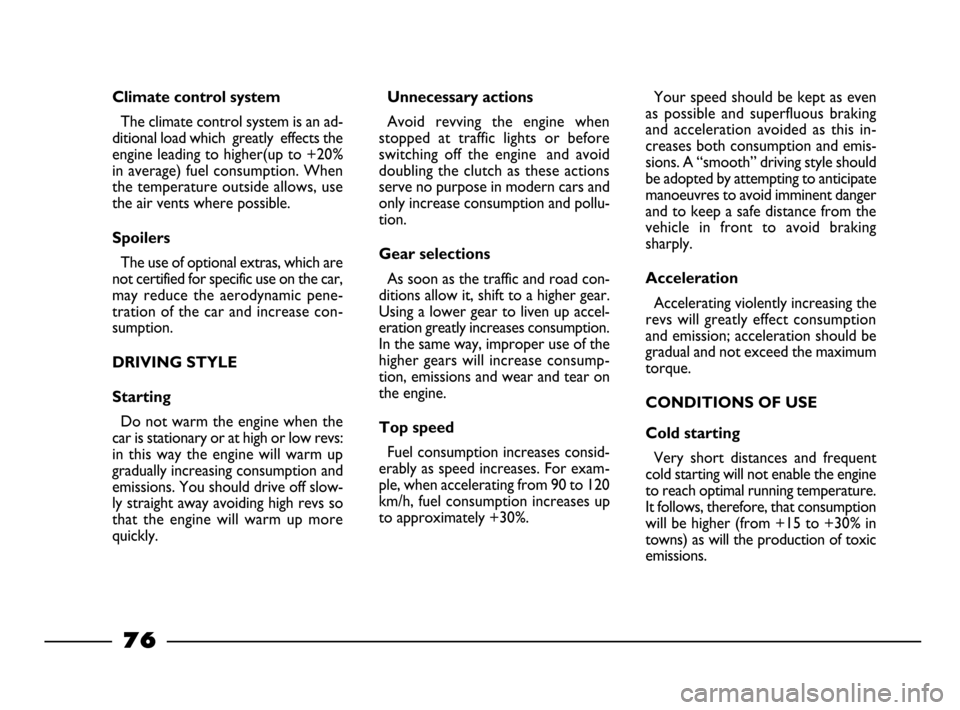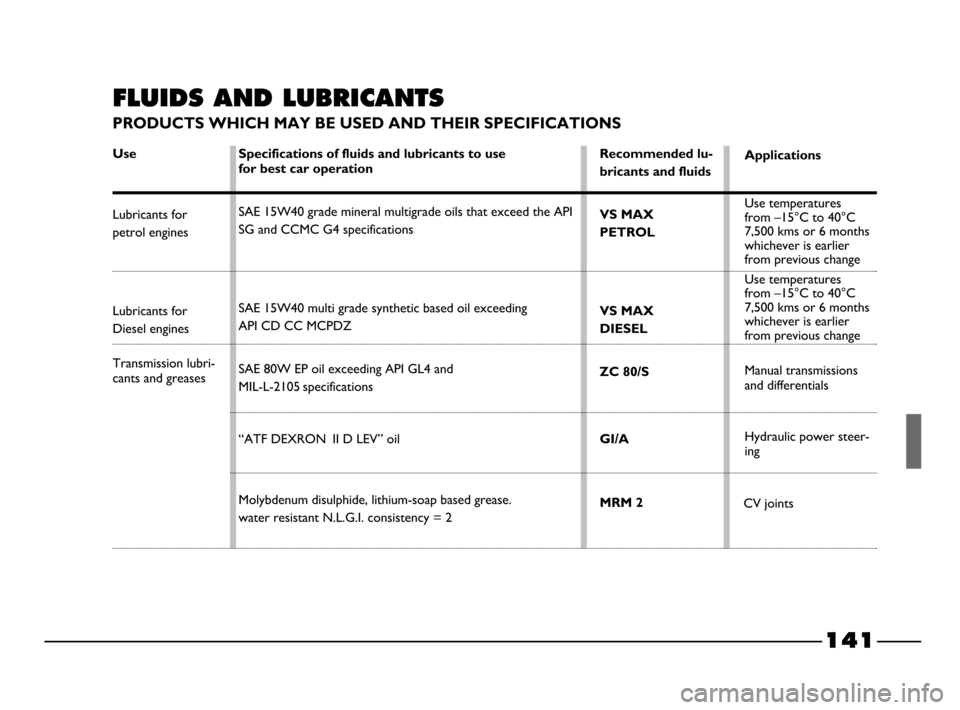oil temperature FIAT PALIO 2003 178 / 1.G India Version Owners Manual
[x] Cancel search | Manufacturer: FIAT, Model Year: 2003, Model line: PALIO, Model: FIAT PALIO 2003 178 / 1.GPages: 156, PDF Size: 6.27 MB
Page 77 of 156

76
Climate control system
The climate control system is an ad-
ditional load which greatly effects the
engine leading to higher(up to +20%
in average) fuel consumption. When
the temperature outside allows, use
the air vents where possible.
Spoilers
The use of optional extras, which are
not certified for specific use on the car,
may reduce the aerodynamic pene-
tration of the car and increase con-
sumption.
DRIVING STYLE
Starting
Do not warm the engine when the
car is stationary or at high or low revs:
in this way the engine will warm up
gradually increasing consumption and
emissions. You should drive off slow-
ly straight away avoiding high revs so
that the engine will warm up more
quickly.
Unnecessary actions
Avoid revving the engine when
stopped at traffic lights or before
switching off the engine and avoid
doubling the clutch as these actions
serve no purpose in modern cars and
only increase consumption and pollu-
tion.
Gear selections
As soon as the traffic and road con-
ditions allow it, shift to a higher gear.
Using a lower gear to liven up accel-
eration greatly increases consumption.
In the same way, improper use of the
higher gears will increase consump-
tion, emissions and wear and tear on
the engine.
Top speed
Fuel consumption increases consid-
erably as speed increases. For exam-
ple, when accelerating from 90 to 120
km/h, fuel consumption increases up
to approximately +30%. Your speed should be kept as even
as possible and superfluous braking
and acceleration avoided as this in-
creases both consumption and emis-
sions. A “smooth” driving style should
be adopted by attempting to anticipate
manoeuvres to avoid imminent danger
and to keep a safe distance from the
vehicle in front to avoid braking
sharply.
Acceleration
Accelerating violently increasing the
revs will greatly effect consumption
and emission; acceleration should be
gradual and not exceed the maximum
torque.
CONDITIONS OF USE
Cold starting
Very short distances and frequent
cold starting will not enable the engine
to reach optimal running temperature.
It follows, therefore, that consumption
will be higher (from +15 to +30% in
towns) as will the production of toxic
emissions.
64-79 03/03/2003 06:45 PM Page 76
Page 142 of 156

141
FLUIDS AND LUBRICANTS
PRODUCTS WHICH MAY BE USED AND THEIR SPECIFICATIONS
Specifications of fluids and lubricants to use
for best car operation
SAE 15W40 grade mineral multigrade oils that exceed the API
SG and CCMC G4 specifications
SAE 15W40 multi grade synthetic based oil exceeding
API CD CC MCPDZ
SAE 80W EP oil exceeding API GL4 and
MIL-L-2105 specifications
“ATF DEXRON II D LEV” oil
Molybdenum disulphide, lithium-soap based grease.
water resistant N.L.G.I. consistency = 2 Transmission lubri-
cants and greases
Recommended lu-
bricants and fluids
VS MAX
PETROL
VS MAX
DIESEL
ZC 80/S
GI/A
MRM 2
CV jointsUse temperatures
from –15°C to 40°C
7,500 kms or 6 months
whichever is earlier
from previous change
Use temperatures
from –15°C to 40°C
7,500 kms or 6 months
whichever is earlier
from previous change
Manual transmissions
and differentials
Hydraulic power steer-
ing
Applications Use
Lubricants for
petrol engines
Lubricants for
Diesel engines
128-143 03/03/2003 07:39 PM Page 141